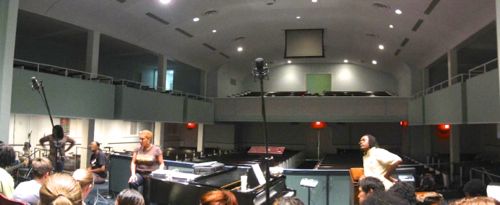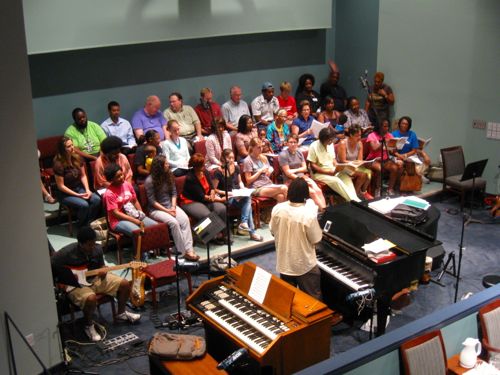This is the second in a series of blog posts with reports and reflections by Peter Slade on his two-week lived theology road trip from New Orleans to Memphis in September 2013.

To read the first post “New Orleans and CCDA”, click here.
I crossed the Pontchartrain and drove on up to Jackson, Mississippi, in time to go to Redeemer Presbyterian Church for Sunday morning worship. Redeemer is a fascinating and unlikely congregation. A church in the conservative Presbyterian Church in America (PCA), its existence is the result of a church split nine years ago in a North Jackson congregation called Trinity Pres. In the 1950s, when Trinity had started, Northside Drive had been a white neighborhood. By 2004, it had “transitioned,” as they say, into an African-American neighborhood. The split in the church may not have been directly about race, but race had played a complicating factor — it was over whether the congregation should stay and work in the neighborhood or move four miles down the road (and across the highway and color line) into a bigger facility.
Redeemer’s website diplomatically summarizes the resulting split:
When Trinity had outgrown the facilities on Northside Drive, it elected to move to a new location on Old Canton Road. This opened a unique opportunity for a portion of the Trinity family to remain at the Northside location in order to continue ministering to the Broadmoor and Broadmeadow neighborhoods.
Over on its site, Trinity Pres’ has a very detailed justification for what happened:
Trinity had reached a point in its demographic niche where future growth and impact in the African American community – the predominant community at its’ Northside Drive location – necessitated African American leadership. The elders became convinced that the location of the church demanded an African American pastor on staff and an integrated body of elders and deacons. The move to Old Canton Road would open the way for a black church on Northside Drive with indigenous leadership.
So to summarize: those who left (the congregation) stayed (in the building) and those who stayed, left!
I had been in Jackson during the Trinity/Redeemer split back in 2004 and I had gone to see Mike Campbell–the African American minister called to Redeemer–preach his first sermon, and now I was fascinated to see how this new congregation was doing. I was particularly interested to see how they were developing a music program to lead worship in this intentional interracial congregation.
Sociologist Gerardo Marti in Worship Across the Racial Divide (OUP, 2012) observed that “Integrated worship is fundamental to the vision of a truly multiracial church“ (4). He also observes that in an exercise as fraught as nurturing a multi-racial community in which so many factors are outside the church leaders’ control, the pastor and the elders can control “the construction of participation through worship music” (15). Marti contends that this ability to control the musical content can lead to the mistaken belief that just by playing the right music the right way a church can determine the racial constituency of the congregation — a kind of “play it and they will come” mentality. What he discovered from his research in California was that it is the practice of making the music together, rather than the type of music being made, that actually proved to be most significant.
“Music alone does not integrate people. The force of the music does not come through its professional quality but rather through the relational connections members share. . . The relationship not the music is celebrated. The music gives occasion for building relationships” (Marti, 176).
Over lunch on Monday, Redeemer’s minister Mike Campbell told me of the church’s dramatic numerical success. Starting with around 100 people for the Sunday morning service, they now have 650-700 attending two morning services. The number of African Americans has also increased from less than 10% in 2004 to around 25% today. So many people are attending that Redeemer had to extend the sanctuary and build a wrap-around balcony.
The sanctuary was not just reconfigured to accommodate more people — the pulpit and the pipe organ have gone — in their place is a space that accommodates the choir, a band– including a Hammond B3 and drums off to the side isolated in a small plexiglass room–with the preacher and assistant pastor sitting at the front of the platform facing the congregation. Suspended over them all is a large celtic cross.
Redeemer has decided to invest in African American gospel musicians to lead the music and choir–Paula Granger is the director and Symeon Robins is her able assistant on keys. The music itself is drawn from distinct musical traditions present in the congregation and led by different members of the music ministry. This particular Sunday, Ryan Dean –the white youth pastor–leads most of the songs with his acoustic guitar. His vernacular is Contemporary Christian Music (CCM) but you can feel the gears shift as the songs change from CCM (“Blessed Be Your Name”) to Gospel (“Highly Exalted”) to Reformed University Fellowship (“The Sands of Time are Sinking”).
As the genre changes the quality and style of the singing changes. CCM is sung in a breathy style with very little volume — it is the music of a personal relationship with Jesus and the singers don’t need to project the sound much further than the space just in front of their lips (after all, Jesus is closer to you than you are to yourself). The effect, even when a song is well known and loved, is to create a warm melodic murmur that can be heard over the band and the amplified singers if you focus your attention on it. But as soon as the choir switches to singing gospel the volume of singing jumps dramatically — gospel singers project to the back of the room and the African Americans are enjoying singing out. The final hymn is a favorite of the Reformed University Fellowship Hymn Book and all of a sudden the white women are singing like the sirens from O Brother, Where Art Thou. Bluegrass, unlike CCM, is a style of singing that encourages projection. These conservative Southern Presbyterians claim this musical product of its student ministry as a distinctive worship genre. They take old nineteenth century hymns (the more emotionally tortured, the better) and set them to new tunes written in a Nashville Americana folk style — think Buddy Miller and the Civil Wars meets the Avett Brothers with a dash of Emmylou Harris.
I am intrigued by the different voices of the congregation–the way the different church traditions are so identifiable not simply in the songs people sing but in the very way they sing them together. In the book Creator Spirit (Baker, 2011, 80), theologian Steve Guthrie points out that St. Paul calls Gentile Christians to sing God’s praises with the Jews in the church to demonstrate the new reality of their unity in Christ. They are to sing with “one voice”(Rom 15-5-11).
After the service Candace and Symeon Robins take me to The Cock of the Walk restaurant. As we eat fried chicken, catfish, hush puppies and greens, I discover that Redeemer isn’t trying to develop a single voice — a musical expression distinctive to the congregation. “We want to be authentic to each genre,” Symeon explains. I can’t decide how to think about this — I am not sure if I am only hearing people sing their own music and being silent on the rest or if I am hearing the distinctive songs of different traditions meeting together on a Sunday morning.
On Tuesday night I come back to Redeemer for choir practice. I stow myself on the back row with the basses where I can’t do too much damage. There are 26 people in the choir stands this evening and fifteen are African American — a proportion much higher than in the congregation (Marti calls this tendency “conspicuous color”). We work hard for 90 minutes and then join hands as we pray together. As I say good bye to Symeon and Paula and we hug I experience something of what the sociologist Marti observed when he wrote that “music gives occasion for building relationships.” But the same could be said of any social event–sociology can only take us so far. Theology gets us further:
“Music cannot summon up from within itself the power to ‘break down the dividing walls’ and ‘abolish the hostility between us’ (see Eph 2:14). This is the work of God. Nevertheless, as with bread and wine, as with the waters of baptism, or as with sexual intimacy, music is one means by which God may teach us community and make it a lived reality among us” (Guthrie 91).



